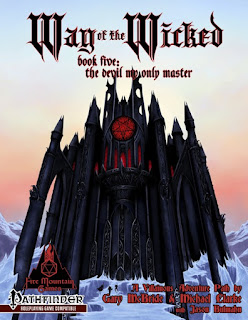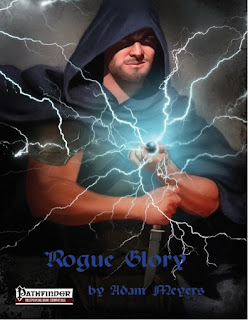Hej everybody!
Once in a while, I stumble across a humble publication that doesn't get the attention it deserves. This is one of these books.
Plots & Ploys: A Skill and Feat Collection
This pdf is 17
pages long, 1 page front cover, 1/2 a page editorial, 1 page SRD,
leaving us with 14 1/2 pages of content, so let's check this out!
This collection offers us first of all new skill uses: You may now use the bluff-skill to fast-talk yourself out of combat, feign injuries or deliver quick secret messages. You may also intimidate foes at massive penalties in a couple of rounds or even as a full round action. Perception-rules to use the skill to listen underwater, soil or pinpoint sounds also serve to enhance the skill - especially useful when using the revised Stealth-rules from Drop Dead Studios' Rogue Glory-supplement. Via Sense Motive, you can quickly scan for enchantments or analyze your foes, though the latter hits one of my pet-peeves and does not provide abstract information, but rather precise BAB, feats etc. - and metagamey information like that is banned in my game. Via Sleight of Hand, you may now conceal held items or steal items usually too large to steal or secretly store items. In a nice display of awareness, none of these skill-uses overlap with the ones provided in Rite Publishing's by now legendary "101 New Skill Uses".
After this section, we're off to the feat part of the pdf, prefaced by a massive 2 1/2 pages of feat-table. The feats are actually rather interesting in the things the endeavor to do: Using a rudimentary kind of echo-location by clicking with the tongue (behavior btw. exhibited by some blind people irl) allows you rudimentarily determine your surroundings even when you otherwise can't due to e.g. darkness. Active Avoidance is also an interesting option that requires Dex and Int 15 as well as dodge and combat expertise and allows you to, as an immediate action, double the AC-bonus versus the next attack of the opponent. An interesting design, especially for dueling characters.
In fact, many of the feats herein offer similarly tactically-themed options to e.g. goad foes into attacking their allies and belittling foes can grant bonuses as long as you and your allies don't get hit. Using sleight of hand instead of the steal combat-maneuver is also covered, though I've seen better uses of that particular concept n other publications. Teamwork, via aiding one another, evading friendly fire and several social feats that e.g. allow you to place suggestions (thankfully with scaling DCs) and even a feat to offer redemption to enemies (which is a streamlined, updated take on the one from the notorious Book of Exalted Deeds).

Beyond that, the feats in this book can be roughly categorized into different quarters: Some expand the new skill uses introduced in here, some enhance teamwork between members of the party (allowing e.g. the PCs to talk one another through e.g. skill checks), some help with the defensive side of things, some enhance social skill-uses in combat- situations and some capitalize on high Int as well as sense motive to display tactical fighters in battle who can benefit from their genius, much like e.g. characters in battle-of-wills-type scenarios à la Death Note. While especially the latter is an interesting concept, at least in my game, I will disconnect the benefits from gaining metagamey information and had hoped the pdf had done the same. Oh well. There also are some minor filler feats that allow access to low-level domain or bloodline abilities for those not so endowed.
The pdf also offers a selection of new item-tricks for cloaks as well as a cohesive example on how the material in this pdf can make fights more dynamic and less about bashing brains in.

Conclusion:
Editing and formatting are good, though not top-notch - I noticed a couple of rough patches here and there like missing blank lines between feats, minor glitches etc., though nothing glaring. Layout adheres to PDG's 2-column no-frills standard and the pdf comes fully bookmarked.
David Nicholas Ross' Plots and Ploys was a kind of frustrating pdf for me to review: On the one hand, these skill-uses and feats are compelling and serve their purpose - they should help to get groups out of kill-em-all-ruts and add an interesting dimension to combats heretofore untapped. On the other hand, this collection uses metagamey information (something I abhor) and some of the feats could be taken to ridiculous places - some of them could have really used a caveat that they don't work on specific types of creatures. That being said, as a DM I'd be wary of introducing this pdf as a whole without some very close scrutiny for respective groups - while the feats per se are not broken, depending on the group they're introduced to, they may prove to be unhinging and change your gaming experience. Seeing how this is the goal of the pdf, though, I won't hold that versus the pdf.
That being said, I also feel that this pdf is slightly below what it could actually have been - with minor revision and slightly more polish, this pdf could have been even better. As provided, I can see it being useful, though not necessarily great for all types of campaigns. This would bring me to a review of 4.5 stars, but the editing glitches and filler material here and there make me settle for a final verdict of 4 stars instead.
Endzeitgeist out.
This collection offers us first of all new skill uses: You may now use the bluff-skill to fast-talk yourself out of combat, feign injuries or deliver quick secret messages. You may also intimidate foes at massive penalties in a couple of rounds or even as a full round action. Perception-rules to use the skill to listen underwater, soil or pinpoint sounds also serve to enhance the skill - especially useful when using the revised Stealth-rules from Drop Dead Studios' Rogue Glory-supplement. Via Sense Motive, you can quickly scan for enchantments or analyze your foes, though the latter hits one of my pet-peeves and does not provide abstract information, but rather precise BAB, feats etc. - and metagamey information like that is banned in my game. Via Sleight of Hand, you may now conceal held items or steal items usually too large to steal or secretly store items. In a nice display of awareness, none of these skill-uses overlap with the ones provided in Rite Publishing's by now legendary "101 New Skill Uses".
After this section, we're off to the feat part of the pdf, prefaced by a massive 2 1/2 pages of feat-table. The feats are actually rather interesting in the things the endeavor to do: Using a rudimentary kind of echo-location by clicking with the tongue (behavior btw. exhibited by some blind people irl) allows you rudimentarily determine your surroundings even when you otherwise can't due to e.g. darkness. Active Avoidance is also an interesting option that requires Dex and Int 15 as well as dodge and combat expertise and allows you to, as an immediate action, double the AC-bonus versus the next attack of the opponent. An interesting design, especially for dueling characters.
In fact, many of the feats herein offer similarly tactically-themed options to e.g. goad foes into attacking their allies and belittling foes can grant bonuses as long as you and your allies don't get hit. Using sleight of hand instead of the steal combat-maneuver is also covered, though I've seen better uses of that particular concept n other publications. Teamwork, via aiding one another, evading friendly fire and several social feats that e.g. allow you to place suggestions (thankfully with scaling DCs) and even a feat to offer redemption to enemies (which is a streamlined, updated take on the one from the notorious Book of Exalted Deeds).
Beyond that, the feats in this book can be roughly categorized into different quarters: Some expand the new skill uses introduced in here, some enhance teamwork between members of the party (allowing e.g. the PCs to talk one another through e.g. skill checks), some help with the defensive side of things, some enhance social skill-uses in combat- situations and some capitalize on high Int as well as sense motive to display tactical fighters in battle who can benefit from their genius, much like e.g. characters in battle-of-wills-type scenarios à la Death Note. While especially the latter is an interesting concept, at least in my game, I will disconnect the benefits from gaining metagamey information and had hoped the pdf had done the same. Oh well. There also are some minor filler feats that allow access to low-level domain or bloodline abilities for those not so endowed.
The pdf also offers a selection of new item-tricks for cloaks as well as a cohesive example on how the material in this pdf can make fights more dynamic and less about bashing brains in.
Conclusion:
Editing and formatting are good, though not top-notch - I noticed a couple of rough patches here and there like missing blank lines between feats, minor glitches etc., though nothing glaring. Layout adheres to PDG's 2-column no-frills standard and the pdf comes fully bookmarked.
David Nicholas Ross' Plots and Ploys was a kind of frustrating pdf for me to review: On the one hand, these skill-uses and feats are compelling and serve their purpose - they should help to get groups out of kill-em-all-ruts and add an interesting dimension to combats heretofore untapped. On the other hand, this collection uses metagamey information (something I abhor) and some of the feats could be taken to ridiculous places - some of them could have really used a caveat that they don't work on specific types of creatures. That being said, as a DM I'd be wary of introducing this pdf as a whole without some very close scrutiny for respective groups - while the feats per se are not broken, depending on the group they're introduced to, they may prove to be unhinging and change your gaming experience. Seeing how this is the goal of the pdf, though, I won't hold that versus the pdf.
That being said, I also feel that this pdf is slightly below what it could actually have been - with minor revision and slightly more polish, this pdf could have been even better. As provided, I can see it being useful, though not necessarily great for all types of campaigns. This would bring me to a review of 4.5 stars, but the editing glitches and filler material here and there make me settle for a final verdict of 4 stars instead.
Endzeitgeist out.







